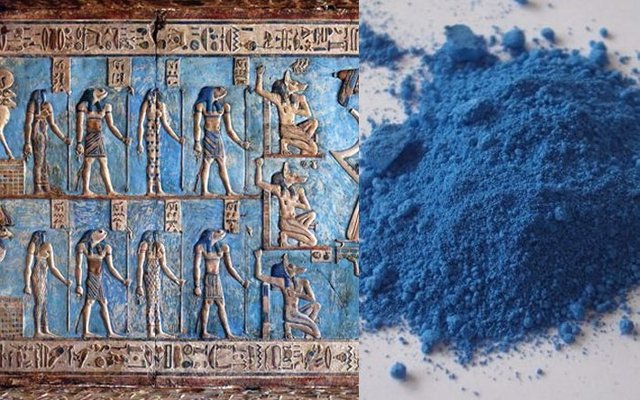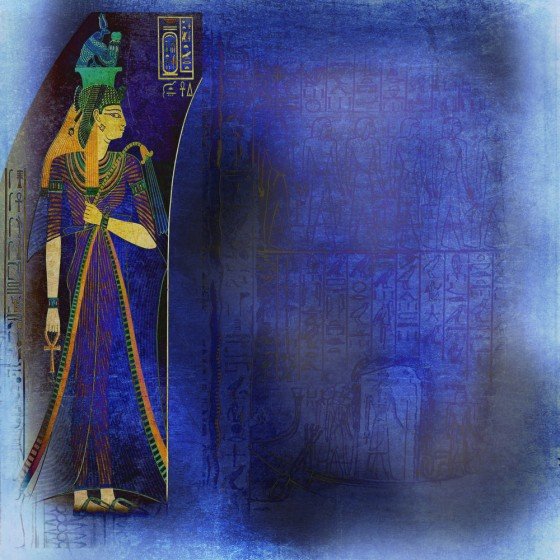The ancient Egyptians 'creativity did not stop at astronomy, medicine, architecture, etc., but rather the manufacturing technology of the various materials. In light of the ancient Egyptians' keenness to decorate their religious facilities from temples and cemeteries in preparation for other life, the ancient Egyptian tombs included funeral furniture and other cemetery artifacts, Gold and sweetened with precious stones and other treasures, the ancient Egyptian was concerned with the decoration of the walls of its tombs and temples and used in this environment, which provided natural materials characterized by stability and resistance against the factors of time and changes.
When the ancient Egyptian noted that some materials were not readily available as copper ores of Azurite and Malakite or the precise observation of their lack of consistency, he resorted to the preparation of another material used for coloring in blue. The result was the production of the oldest industrial prepared material in history.

The color of the blue color of Egypt was a technological breakthrough in ancient Egypt and began to use from the era of the ancient state "the fourth Dynasty 2575-2467 BC." The use of this article to color blue without interruption until the Roman era, and was exported to other civilizations such as Greek and Roman civilization.
This material is copper silicate, calcium or cappurite (CaCuSi4O10) and was prepared by heating a set of basic materials necessary for the preparation of color copper ores or some copper alloys such as bronze especially in the modern state era, in addition to the abundant amount of sand beside limestone powder and a small proportion of salt Which were mixed together in the form of balls and heated at temperatures ranging from 800 to 1000 ° C, and the final product has a distinct blue color and crystalline grains of varying sizes with a high degree of stability to a large extent.
Apart from the importance of color in ancient Egypt and its use in the coloring and decoration of tombs, temples and other artifacts, tools and magnificence of its manufacturing technology, which has been associated with Egypt, recent studies on this article, including a research published not long ago in the Journal of the American Chemical Society, The thickness of the Egyptian blue color does not exceed the thickness of the nanoparticles (exact 1000 times the thickness of the human hair).
Since 2009 it has been noted that the Egyptian blue is not only an old colored material but has special characteristics and characteristics. This is confirmed in his research by Dr. Gianluca Accorsi, a researcher in nanoscience at the Italian National Research Center (CNR) that the Egyptian blue, when exposed to visible light, emits close infrared rays.
As shown in the Bulletin of the British Museum, this feature found in the Egyptian blue and the emission of a strong infrared light when exposed to visible light useful to identify the granules of this same article even a distance of a few meters, a property useful in identifying the remains of a very small sample of archaeological material What has already been applied by the British Museum to identify the remains of color of marble sculptures from the Greek Parthenon temple.
On the other hand, this can have many applications in different fields, since these generated "near infrared radiation" that penetrates the bodies more than other waves and therefore can have many applications, especially in the means of communication and remote control both Television, cars, inkjet printers, etc., as well as generating high-cost laser beams, as well as medical applications in human tissue radiographs.
In a study of researchers from the University of Curtin in Australia, it was found that this feature helps investigators to identify the fingerprints, especially on shiny surfaces. The research team crushed the Egyptian blue powder for soft powder and exposed it to light rays, and then the rays generated by sensitive cameras were captured.
The Egyptian blue components are cheap and need to be prepared. They provide copper, limestone and alkaline magma, which are abundant in Egypt, giving the Egyptian Blue another advantage when generating nearby infrared radiation at low cost and use in many industrial and medical fields.
The ancient Egyptian has succeeded in impressing the world with its past and present with its genius and the results of its experiences and experiences in a way that is witnessed by the eyes of the world from the drawings of the graves and the magnificence of the archaeological holdings that are rich in most of the world's museums. Also in the various industrial and medical applications of materials invented by the ancient Egyptian for the first time in thousands of years. Modern applications in our time.

Great post! I love reading about ancient times.
Here's also a tip from me: Try using normal font size for text instead. Use bold and big for titles and subtitles. It makes reading more easy on the eye :)
Downvoting a post can decrease pending rewards and make it less visible. Common reasons:
Submit
thank you so much for your advice it's very useful
Downvoting a post can decrease pending rewards and make it less visible. Common reasons:
Submit
The ancient Egypt is civilisation is truly awesome and some are unbelievable. I even thought only the pyramid exemplify their ingenuity, I never knew their colour prowess. I'm glad I learnt something new.
Downvoting a post can decrease pending rewards and make it less visible. Common reasons:
Submit